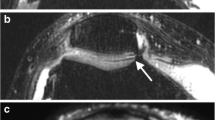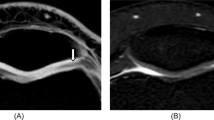Abstract
Objective
To evaluate the diagnostic accuracy of water-excitation (WE) 3D FLASH and fat-saturated (FS) proton density-weighted (PDw) TSE MR imaging for detecting, grading, and sizing articular cartilage lesions of the knee.
Design and patients
A total of 26 patients underwent MR imaging prior to arthroscopy with the following sequences: (1) WE 3D FLASH: 28/11 ms, scan time: 4 min 58 s, flip angle: 40°; (2) FS PDw TSE: 3433/15 ms, scan time: 6 min 15 s, flip angle: 180°. Grade and size of the detected lesions were quantified and compared with the results of arthroscopy for each compartment.
Results
The sensitivity, specificity, positive and negative predictive values, and accuracy for detecting cartilage lesions were 46%, 92%, 81%, 71% and 74% for WE 3D FLASH and 91%, 98%, 96%, 94% and 95% for FS PDw TSE MR imaging. WE 3D FLASH correlated significantly with arthroscopy for grading on the patella (P<0.0001) and the femoral trochlea (P=0.02) and for sizing on the femoral trochlea (P=0.03). FS PDw correlated significantly (P<0.0001) with arthroscopy for grading and sizing on all compartments.
Conclusion
FS PDw TSE is an accurate method for detecting, grading and sizing articular cartilage lesions of the knee and yielded superior results relative to WE 3D FLASH MR imaging.




Similar content being viewed by others
References
Disler DG, Recht MP, McCauley TR. MR imaging of articular cartilage. Skeletal Radiol 2000; 29:367–377.
Bredella MA, Tirman PF, Peterfy CG, et al. Accuracy of T2-weighted fast spin-echo MR imaging with fat saturation in detecting cartilage defects in the knee: comparison with arthroscopy in 130 patients. AJR Am J Roentgenol 1999; 172:1073–1080.
McCauley TR, Disler DG. Magnetic resonance imaging of articular cartilage of the knee. J Am Acad Orthop Surg 2001; 9:2-8.
Bachmann G, Heinrichs C, Jurgensen I, Rominger M, Scheiter A, Rau WS. Comparison of different MRT techniques in the diagnosis of degenerative cartilage diseases. In vitro study of 50 joint specimens of the knee at T1.5. Rofo 1997; 166:429–436.
Brossmann J, Frank LR, Pauly JM, et al. Short echo time projection reconstruction MR imaging of cartilage: comparison with fat-suppressed spoiled GRASS and magnetization transfer contrast MR imaging. Radiology 1997; 203:501–507.
Potter HG, Linklater JM, Allen AA, Hannafin JA, Haas SB. Magnetic resonance imaging of articular cartilage in the knee. An evaluation with use of fast-spin-echo imaging [see comments]. J Bone Joint Surg Am 1998; 80:1276–1284.
Rand T, Brossmann J, Pedowitz R, Ahn JM, Haghigi P, Resnick D. Analysis of patellar cartilage. Comparison of conventional MR imaging and MR and CT arthrography in cadavers. Acta Radiol 2000; 41:492–497.
Murphy BJ. Evaluation of grades 3 and 4 chondromalacia of the knee using T2*-weighted 3D gradient-echo articular cartilage imaging. Skeletal Radiol 2001; 30:305–311.
Ahn JM, Kwak SM, Kang HS, et al. Evaluation of patellar cartilage in cadavers with a low-field-strength extremity-only magnet: comparison of MR imaging sequences, with macroscopic findings as the standard. Radiology 1998; 208:57–62.
Graichen H, Springer V, Flaman T, et al. Validation of high-resolution water-excitation magnetic resonance imaging for quantitative assessment of thin cartilage layers. Osteoarthritis Cartilage 2000; 8:106–114.
Hyhlik-Durr A, Faber S, Burgkart R, et al. Precision of tibial cartilage morphometry with a coronal water-excitation MR sequence. Eur Radiol 2000; 10:297–303.
Springer V, Graichen H, Stammberger T, Englmeier KH, Reiser M, Eckstein F. Noninvasive analysis of cartilage volume and cartilage thickness in the human elbow joint using MRI. Anat Anz 1998; 180:331–338.
Heudorfer L, Hohe J, Faber S, Englmeier KH, Reiser M, Eckstein F. [Precision MRI-based joint surface and cartilage density analysis of the knee joint using rapid water-excitation sequence and semi-automatic segmentation algorithm]. Biomed Tech 2000; 45:304-310.
Recht MP, Kramer J, Marcelis S, et al. Abnormalities of articular cartilage in the knee: analysis of available MR techniques. Radiology 1993; 187:473–478.
Noyes FR, Stabler CL. A system for grading articular cartilage lesions at arthroscopy. Am J Sports Med 1989; 17:505–513.
Peh WC, Chan JH. Artifacts in musculoskeletal magnetic resonance imaging: identification and correction. Skeletal Radiol 2001; 30:179–191.
Disler DG, McCauley TR, Kelman CG, et al. Fat-suppressed three-dimensional spoiled gradient-echo MR imaging of hyaline cartilage defects in the knee: comparison with standard MR imaging and arthroscopy. AJR Am J Roentgenol 1996; 167:127–132.
Potter HG, Rodeo SA, Wickiewicz TL, Warren RF. MR imaging of meniscal allografts: correlation with clinical and arthroscopic outcomes. Radiology 1996; 198:509–514.
Gray ML, Burstein D, Xia Y. Biochemical (and functional) imaging of articular cartilage. Semin Musculoskelet Radiol 2001; 5:329–343.
Hohe J, Faber S, Stammberger T, Reiser M, Englmeier KH, Eckstein F. A technique for 3D in vivo quantification of proton density and magnetization transfer coefficients of knee joint cartilage. Osteoarthritis Cartilage 2000; 8:426–433.
Gagliardi JA, Chung EM, Chandnani VP, et al. Detection and staging of chondromalacia patellae: relative efficacies of conventional MR imaging, MR arthrography, and CT arthrography. AJR Am J Roentgenol 1994; 163:629–636.
Bredella MA, Tirman PF, Wischer TK, Belzer J, Taylor A, Genant HK. Reactive synovitis of the knee joint: MR imaging appearance with arthroscopic correlation. Skeletal Radiol 2000; 29:577–582.
Lee JH, Singh TT, Bolton G. Axial fat-saturated FSE imaging of knee: appearance of meniscal tears. Skeletal Radiol 2002; 31:384–395.
Jansson KA, Karjalainen PT, Harilainen A, et al. MRI of anterior cruciate ligament repair with patellar and hamstring tendon autografts. Skeletal Radiol 2001; 30:8-14.
Recht M, Bobic V, Burstein D, et al. Magnetic resonance imaging of articular cartilage. Clin Orthop 2001: Suppl 391:379–396.
Author information
Authors and Affiliations
Corresponding author
Rights and permissions
About this article
Cite this article
Mohr, A. The value of water-excitation 3D FLASH and fat-saturated PDw TSE MR imaging for detecting and grading articular cartilage lesions of the knee. Skeletal Radiol 32, 396–402 (2003). https://doi.org/10.1007/s00256-003-0635-z
Received:
Revised:
Accepted:
Published:
Issue Date:
DOI: https://doi.org/10.1007/s00256-003-0635-z




